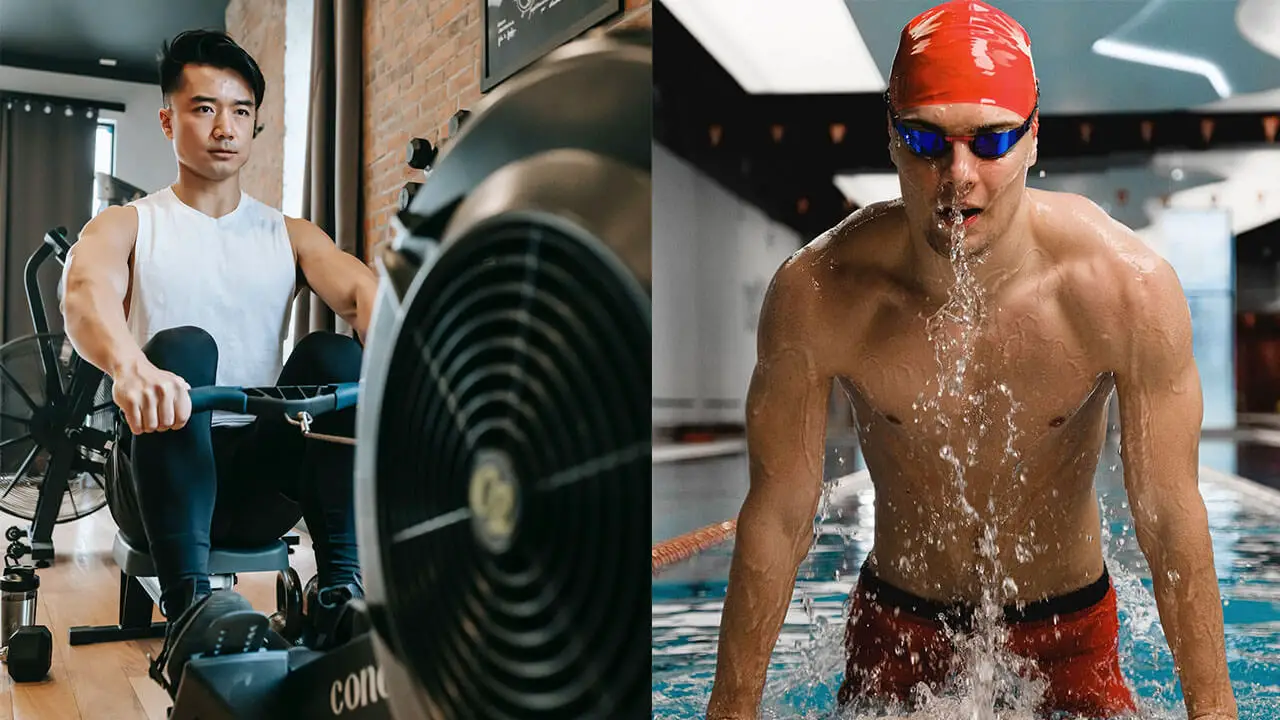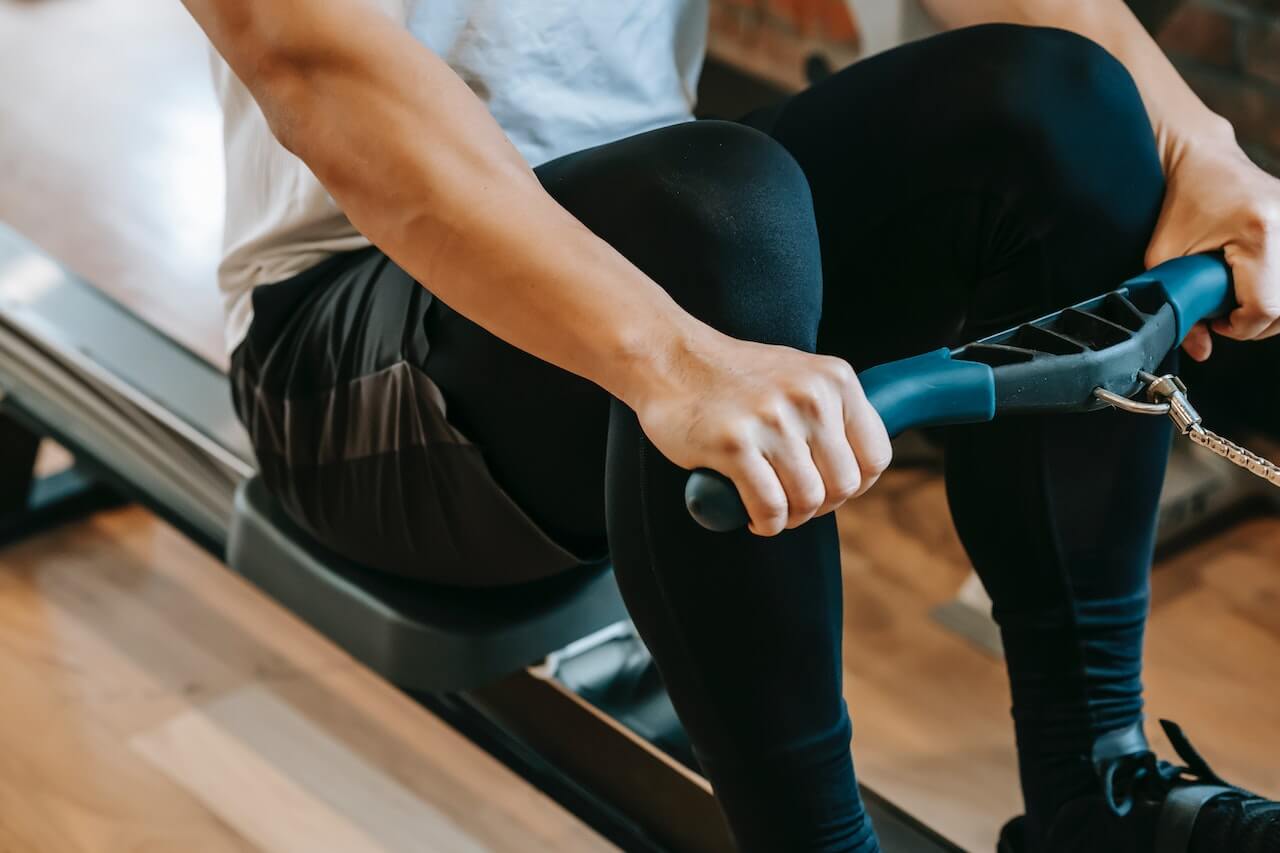Have you ever wondered if rowing could be a suitable alternative to swimming? Many people often look for low-impact exercises that provide a full-body workout while being easy on their joints, and perhaps rowing can fit that bill when it comes to a swimming alternative.

If your goal is simply to lose weight or improve your cardiovascular health, then yes, rowing is equivalent to swimming in terms of calories burned and cardiovascular benefits. However, if your goal is to improve your swimming performance, then rowing can complement your swimming workouts, but cannot replace them.
In this article, we will go into the comparisons between swimming and rowing to help you decide if and how you should incorporate rowing into your workout routine.
Comparing Rowing and Swimming
Physical Demands and Benefits
Comparing rowing to swimming is like comparing apples to oranges. Sure, there are some similarities at first glance, but overall they are quite different.
Swimming incorporates a range of movements done in a horizontal position, which works several muscle groups simultaneously, with more of an emphasis on the upper body. This full-body workout boosts your cardiovascular health, helping you maintain a healthy heart.
Rowing, on the other hand, mainly involves pulling and pushing movements in a seated position – pulling with the arms and pushing with the legs. Just like swimming, rowing offers a full-body workout, contributing to improved cardiovascular health, however with more of an emphasis on the legs.
Both activities are known for being low-impact exercise, making them gentle on your joints.
In terms of muscle groups, both swimming and rowing engage your core, arms, legs, and back muscles. However, rowing may provide more focused strength and resistance training since you can continuously increase the resistance, whereas the resistance of water remains the same.
Accessibility and Practicality
When considering the accessibility and practicality of each, swimming typically requires access to a pool or other suitable water body, which could be a limiting factor for some.
Rowing can also be done both indoors and outdoors, either on a rowing machine or in a real boat on the water.
Equipment and cost also differ between these two exercises. Swimming involves minimal equipment – just a swimsuit, goggles, and perhaps a cap.
Rowing machines, though affordable, do require an initial investment, but they’re a convenient way to work out at home. If you’re planning to row outdoors, obtaining access to a boat and proper rowing gear is essential.
Rowing machines have the advantage over swimming in terms of accessibility because, if you buy one for personal use, then you can easily use it all the time. The same cannot be said for swimming; unless you’re willing to spend thousands on an infinity pool/swim spa, it’s hard to get a good swim workout at home.
Benefits and Drawbacks
Advantages of Rowing

Rowing is a fantastic low-impact exercise that offers a full-body workout, engaging all nine major muscle groups in your body.
This workout is perfect for burning calories and building muscle without putting too much stress on your joints. The rowing machine experience provides an excellent cardiovascular and aerobic exercise, strengthening your heart and lungs while you work up a sweat.
Additionally, rowing targets your core muscles, which is essential for overall stability and strength. As you row, you’ll also develop better posture and reduce the risk of back pain, making it a great option if you spend a lot of time sitting at a desk.
Advantages of Swimming

Swimming is another fantastic low-impact exercise that provides numerous health benefits. As you glide through the water, your body enjoys a natural cooling effect, so you won’t feel overheated while working out.
Incorporating various swim strokes, swimming challenges and enhances your breathing technique. This full-body workout also helps to improve cardiovascular fitness, toning your muscles and increasing your lung capacity.
Swimming is an excellent option for those looking to relieve stress and relax the mind, as the water’s buoyancy offers support for your body, easing tension in your muscles.
Understanding the Limits of Each
While both rowing and swimming provide significant benefits, they aren’t without flaws. For instance, if you’re looking specifically to build muscle mass, rowing might be a better option because of the adjustable resistance, whereas swimming focuses entirely on cardio.
On the other hand, if you’re aiming to improve your connection to the water and want a workout that incorporates elements of relaxation, swimming is a fantastic choice. However, remember that access to a pool can be more challenging than finding a rowing machine.
Also, there isn’t as much carryover between these activities as you might think. If your goal is to improve at swimming but all you’re doing is rowing, then you won’t magically get better at swimming. You need to both swim and row to reap the benefits of both.
When Rowing May be a Good Substitute for Swimming
Physical Limitations or Health Concerns
Sometimes, health conditions or physical limitations can make swimming a less suitable exercise option.
For instance, certain injuries or joint problems may make swimming difficult or even impossible. In these cases, rowing can be an excellent alternative, as it is a low-impact workout that still offers a comprehensive, full-body exercise experience.
Additionally, rowing can be a better choice if you suffer from allergies or skin sensitivities related to chlorine or other pool chemicals.
Climate and Location Concerns
Climate and location can play a significant role in determining whether swimming or rowing is a more practical exercise option.
In areas with harsh winters or limited access to open water or pools, swimming may not be feasible year-round.
In contrast, rowing machines are readily available in most gyms or you can buy one for home use, making rowing a more accessible option regardless of weather conditions or location.
This accessibility allows you to maintain a consistent workout routine without being constrained by seasonal or geographic limitations.
Training Goals and Preferences
Your personal fitness goals and preferences can influence whether rowing or swimming is the better choice for you.
If you’re looking to build muscle, rowing might be a more suitable option, as it is better for muscle building compared to swimming. Additionally, if you prefer indoor workouts or enjoy tracking your progress with digital metrics, using a rowing machine may be more appealing.
Moreover, integrating rowing into your exercise routine can serve as a valuable form of cross-training.
For swimmers, rowing helps build crucial muscles and develop core strength, making it a useful complementary workout. Spending 10-15 minutes rowing as a warm-up before swimming or strength training can enhance your overall performance and help prevent injuries.
Frequently Asked Questions
What muscles are targeted by rowing compared to swimming?
Rowing primarily targets the back, shoulders, arms, and legs especially, while also engaging the core for stability. While the exact muscles engaged in swimming can vary depending on the stroke, swimming generally works the upper body, lower body, and core, with a greater emphasis on the shoulders, chest, and back.
Can I achieve the same cardiovascular benefits from rowing as I can from swimming?
Yes, both swimming and rowing are excellent cardiovascular workouts. Both exercises increase heart rate and oxygen consumption, promoting improved cardiovascular health and endurance. The level of cardiovascular benefits is largely dependent on the intensity and duration of the workout, regardless of the exercise.
Which exercise burns more calories: swimming or rowing?
On average, both exercises burn a similar amount of calories per hour.
Can rowing replace swimming for cross-training purposes?
Rowing can indeed serve as an effective cross-training activity for swimmers as it complements the muscle groups and cardiovascular system used in swimming. It also offers a change in movement dynamics and environment, which can prevent overuse injuries and mental burnout.
What are the risks of injury associated with rowing compared to swimming?
Rowing, especially on a machine, can pose risks of back and shoulder injuries if not done with proper form. On the other hand, swimming can lead to shoulder injuries due to repetitive movements. Both exercises, when performed correctly and with proper warm-up and cool-down, have relatively low injury rates.
Does rowing offer the same therapeutic and meditative benefits as swimming?
While both activities can be therapeutic and meditative, the experience can be quite different. Swimming often provides a sensory deprivation experience and rhythmic breathing that many find meditative. Rowing, in contrast, offers rhythmic movement and focus on form that can be mindful and calming.
Can I maintain my swimming form and conditioning if I start rowing instead?
Rowing can help maintain general cardiovascular fitness and muscular strength, but it doesn’t specifically train the muscles and coordination needed for swimming strokes. If you want to maintain your swimming form, it’s best to continue swimming on a regular basis.
Is rowing a better choice for indoor workouts as compared to swimming?
Rowing can be more accessible for indoor workouts, particularly for those who do not have easy access to an indoor swimming pool. Rowing machines are widely available in most gyms and can also be used at home, making it a convenient indoor exercise option.
How do the strength and resistance aspects of rowing compare to swimming?
Rowing and swimming both provide resistance training, as they involve moving against the resistance of water or a rowing machine’s settings. However, rowing is often considered more strength-focused, particularly for the upper body and legs, while swimming provides a more balanced whole-body workout.
What are some considerations before transitioning from swimming to rowing?
Before transitioning from swimming to rowing, consider factors like your current fitness level, any existing injuries or health conditions, and your training goals. Additionally, learning proper rowing technique is crucial to prevent injuries. Ideally, you should still be swimming and using rowing to complement your training, not replace it.
Sources:

